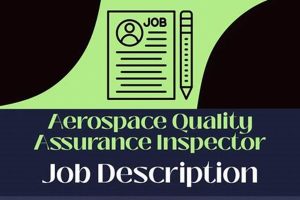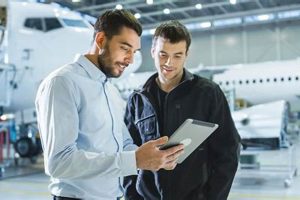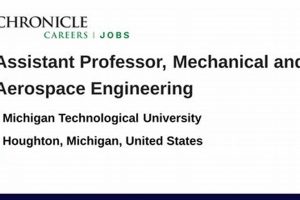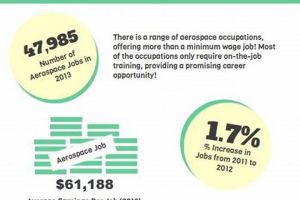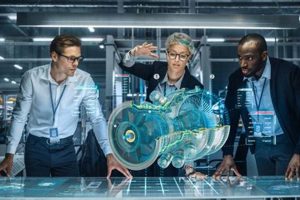Positions in the aerospace technology sector encompass a diverse range of roles focused on the design, development, testing, and maintenance of aircraft, spacecraft, and related systems. These positions require a strong foundation in engineering, mathematics, and computer science, often involving specialized knowledge in areas such as aerodynamics, propulsion, materials science, and avionics. Examples include aerospace engineers, software developers specializing in flight control systems, and technicians involved in the manufacturing and testing of aerospace components.
The significance of contributing to the advancement of flight and space exploration is substantial, driving technological innovation and contributing to national security, scientific discovery, and economic growth. Historically, this field has been at the forefront of technological advancements, pushing the boundaries of what is possible and fostering the development of new materials, processes, and technologies that have applications far beyond the realm of aviation and space travel.
This discussion will delve into the skills and qualifications typically required for success in this dynamic field, explore various career paths and specializations, and examine the current trends and future outlook for individuals pursuing opportunities within this innovative and vital sector.
Achieving a successful career in the aerospace technology sector requires a strategic approach, focusing on skill development, networking, and a proactive job search. The following tips provide guidance for individuals seeking to enter or advance within this competitive field.
Tip 1: Acquire a Strong Educational Foundation: A bachelor’s degree in aerospace engineering, mechanical engineering, electrical engineering, or a related field is generally a prerequisite. Advanced degrees, such as a Master’s or Ph.D., can enhance career prospects and open doors to specialized roles.
Tip 2: Develop Specialized Technical Skills: Focus on developing expertise in areas such as CAD/CAM software, finite element analysis (FEA), computational fluid dynamics (CFD), or specific programming languages relevant to aerospace applications (e.g., MATLAB, Python, C++).
Tip 3: Gain Practical Experience Through Internships: Seek out internship opportunities with aerospace companies, research institutions, or government agencies. Internships provide invaluable hands-on experience and exposure to the industry.
Tip 4: Build a Professional Network: Attend industry conferences, join professional organizations such as the American Institute of Aeronautics and Astronautics (AIAA), and connect with professionals in the field through online platforms like LinkedIn. Networking can lead to job leads and mentorship opportunities.
Tip 5: Tailor Resumes and Cover Letters: Customize resumes and cover letters to specifically address the requirements of each position. Highlight relevant skills, experience, and accomplishments, emphasizing quantifiable results whenever possible.
Tip 6: Prepare Thoroughly for Interviews: Research the company and the specific role, and practice answering common interview questions. Be prepared to discuss technical projects, problem-solving skills, and career aspirations.
Tip 7: Obtain Relevant Certifications: Consider obtaining certifications relevant to the target role. For example, certifications in project management, quality assurance, or specific software packages can demonstrate competence and enhance credibility.
By following these guidelines, individuals can increase their chances of securing and succeeding in positions that contribute to this technologically advanced sector. Continuous learning and adaptability are essential for long-term success in the dynamic aerospace industry.
The subsequent sections will explore specific specializations within the field, providing a more detailed understanding of the opportunities available and the pathways to pursue them.
1. Innovation
In the realm of aerospace technology, innovation serves as the cornerstone for progress, profoundly influencing the evolution of aircraft, spacecraft, and related systems. The pursuit of novel solutions and the continuous refinement of existing technologies are integral to maintaining competitiveness, enhancing safety, and expanding the boundaries of what is achievable.
- Advanced Materials and Manufacturing
The development and integration of lightweight, high-strength materials, such as composites and advanced alloys, are crucial for improving fuel efficiency, reducing structural weight, and enhancing the performance of aircraft and spacecraft. Innovative manufacturing techniques, like additive manufacturing (3D printing), enable the creation of complex geometries and customized components, streamlining production processes and reducing material waste. Examples include the use of carbon fiber reinforced polymers in aircraft wings and the 3D printing of rocket engine components.
- Autonomous Systems and Artificial Intelligence
The integration of autonomous systems and AI in aerospace applications is transforming flight operations, navigation, and decision-making processes. AI-powered systems can enhance situational awareness, automate flight control functions, and optimize flight paths, leading to improved safety and efficiency. Examples include autonomous drones for aerial surveillance, AI-based pilot assistance systems, and machine learning algorithms for predictive maintenance.
- Sustainable Propulsion and Energy Sources
Addressing environmental concerns requires the development of sustainable propulsion systems and alternative energy sources for aircraft and spacecraft. Innovations in electric propulsion, hybrid-electric systems, and sustainable aviation fuels (SAF) are aimed at reducing greenhouse gas emissions and minimizing the environmental impact of air travel. Examples include electric vertical takeoff and landing (eVTOL) aircraft, hybrid-electric regional airliners, and the development of biofuels derived from algae and other sustainable feedstocks.
- Space Exploration Technologies
The pursuit of space exploration necessitates continuous innovation in propulsion systems, life support systems, and robotic technologies. Advanced rocket engines, reusable spacecraft, and autonomous rovers are essential for enabling missions to the Moon, Mars, and beyond. Examples include the development of powerful rocket engines like the SpaceX Raptor, the design of habitable modules for long-duration space missions, and the deployment of robotic rovers for scientific exploration of other planets.
These innovations, while distinct, collectively contribute to the growth and advancement of aerospace technology. The ability to foster and implement these changes directly impacts the creation of specialized roles within the sector. These improvements, through novel technologies and optimized systems, further drive efficiency, sustainability, and exploration capabilities.
2. Engineering
Engineering disciplines are central to the aerospace technology sector, providing the foundational knowledge and skills necessary for the design, development, and implementation of complex systems. These disciplines contribute directly to various roles, shaping the skill sets required and impacting the trajectory of advancements in flight and space exploration.
- Aerospace Engineering
Aerospace engineering focuses on the design, construction, and testing of aircraft and spacecraft. Professionals in this area are involved in aerodynamics, propulsion, structural analysis, and flight control systems. They may work on projects ranging from commercial airliners and military aircraft to satellites and space probes. The core function of aerospace engineers is to ensure that aircraft and spacecraft meet performance, safety, and regulatory requirements. For example, aerospace engineers might design a new wing for an airplane to improve fuel efficiency or develop a navigation system for a spacecraft exploring Mars. These activities directly translate into positions such as design engineer, structural analyst, and flight test engineer.
- Mechanical Engineering
Mechanical engineers are instrumental in the design and analysis of mechanical systems used in aircraft and spacecraft, including engines, landing gear, and hydraulic systems. They apply principles of thermodynamics, fluid mechanics, and heat transfer to optimize performance and reliability. For example, mechanical engineers design and test turbine engines for aircraft or develop cooling systems for spacecraft electronics. Their expertise is critical in roles like propulsion engineer, thermal analyst, and systems engineer.
- Electrical Engineering
Electrical engineers play a vital role in the design and development of electrical systems for aircraft and spacecraft, including power distribution, avionics, and communication systems. They work with circuits, sensors, and software to ensure the reliable operation of critical functions. For example, electrical engineers design the electrical wiring and control systems for an aircraft’s cockpit or develop the communication systems for a satellite. These activities translate into positions such as avionics engineer, power systems engineer, and embedded systems engineer.
- Materials Science and Engineering
Materials scientists and engineers are responsible for the selection, testing, and development of materials used in aerospace applications. They focus on optimizing the strength, weight, and durability of materials to withstand extreme conditions. For example, materials scientists develop lightweight composite materials for aircraft structures or heat-resistant materials for spacecraft heat shields. Their expertise is essential in roles like materials engineer, composites engineer, and failure analysis engineer.
The interconnectedness of these engineering disciplines is paramount to the advancements within the aerospace field. The ability to integrate knowledge from these distinct areas creates a synergistic approach to solving complex problems and developing cutting-edge technologies. The positions within this sector require a comprehensive understanding of these engineering principles to continually push the boundaries of what is possible.
3. Software
Software is an indispensable component of contemporary aerospace technology. Its development and deployment drive a vast array of critical functions, directly influencing the performance, safety, and efficiency of aircraft, spacecraft, and related systems. The increasing complexity of aerospace systems necessitates sophisticated software solutions to manage and control these multifaceted operations. For example, flight control systems rely on intricate software algorithms to maintain stability and navigate aircraft, while satellite communication systems require robust software to transmit and process data effectively. This reliance creates a significant demand for skilled software professionals within the industry.
The demand for software specialists extends across various facets of aerospace technology. Embedded systems engineers develop and maintain the software that controls onboard computers and electronic components. Simulation and modeling engineers create software tools to simulate flight conditions, test designs, and analyze performance characteristics. Cybersecurity experts safeguard aerospace systems against cyber threats, protecting sensitive data and ensuring the integrity of critical infrastructure. Further examples include the development of air traffic control software, mission planning software for space exploration, and data analysis tools for interpreting sensor data collected by aircraft and spacecraft. Each of these applications highlights the pivotal role of software in modern aerospace endeavors.
In summary, software development is integral to the advancement and operational success of the aerospace technology sector. The industry’s dependence on sophisticated software solutions has created a wide range of specialized roles for software engineers, developers, and cybersecurity experts. The ability to design, implement, and maintain reliable and secure software is paramount for ensuring the safety, efficiency, and continued innovation within the aerospace domain.
4. Manufacturing
Manufacturing processes form the core of the aerospace industry, converting designs and engineering specifications into tangible aircraft and spacecraft components. The precision and quality demanded in aerospace manufacturing necessitate specialized skills, creating a range of technical positions that directly contribute to the final product.
- Precision Machining and Fabrication
Aerospace manufacturing relies heavily on precision machining techniques to create components with tight tolerances and complex geometries. This includes processes such as CNC milling, turning, and grinding. Fabricating structures involves welding, forming, and assembling components into larger assemblies. For example, creating turbine blades for jet engines requires micron-level accuracy. This translates to positions such as CNC machinists, tool and die makers, and skilled welders, all critical for producing high-quality aerospace parts.
- Composites Manufacturing
The increasing use of composite materials in aircraft structures has led to specialized manufacturing processes such as layup, curing, and bonding. These materials offer high strength-to-weight ratios but require careful handling and processing to ensure structural integrity. Laying up carbon fiber plies to create aircraft wings and fuselages exemplifies this facet. This generates demand for composite technicians, manufacturing engineers specializing in composites, and quality control inspectors focused on composite materials.
- Assembly and Integration
The assembly of individual components into larger subassemblies and ultimately into complete aircraft or spacecraft requires meticulous attention to detail and adherence to strict quality standards. This includes installing systems, wiring harnesses, and instrumentation. Assembling an aircraft wing involves integrating the spars, ribs, skin panels, and control surfaces. This generates roles for aircraft mechanics, assembly technicians, and systems integrators, who are responsible for ensuring proper functionality and reliability.
- Quality Assurance and Inspection
Rigorous quality assurance and inspection processes are essential throughout the manufacturing process to ensure that all components and assemblies meet stringent requirements. This involves using non-destructive testing (NDT) methods, dimensional inspections, and material testing. Examples include X-raying welds to detect flaws and using coordinate measuring machines (CMMs) to verify dimensions. This leads to positions such as quality control inspectors, NDT technicians, and metrologists, who are responsible for identifying and resolving any defects or deviations from specifications.
These facets of manufacturing demonstrate its fundamental role in shaping the available career paths within the aerospace sector. From precision machining to quality assurance, these specialized processes require trained professionals to uphold the highest standards of safety and performance expected in this critical industry.
5. Research
Research is a fundamental driver of advancement within the aerospace technology sector, serving as the genesis for new technologies, improved designs, and enhanced operational capabilities. Its influence permeates virtually every facet of aerospace, from materials science and propulsion systems to avionics and space exploration. The investment in research directly shapes the types of roles available, influencing skill requirements and career trajectories. For example, government-funded research into hypersonic flight necessitates the employment of aerodynamicists, materials scientists, and control systems engineers. Similarly, corporate-sponsored research into electric propulsion systems creates opportunities for electrical engineers and software developers specializing in power electronics and motor control algorithms. Without sustained research efforts, the progress and competitiveness of the industry would stagnate, limiting the scope and potential of associated career paths.
The practical applications of aerospace research are far-reaching, impacting both military and civilian sectors. Research into advanced sensor technologies leads to improved surveillance capabilities and enhanced air traffic control systems. Studies in human factors contribute to the design of safer and more efficient aircraft cockpits. Materials research results in the development of lighter and stronger structural components, which improve fuel efficiency and aircraft performance. Furthermore, research into space propulsion systems is crucial for enabling deeper space exploration and the development of satellite-based communication and navigation systems. These applications showcase the direct link between research investments and the tangible benefits realized by various end-users. For instance, the development of composite materials through research has significantly reduced aircraft weight, directly lowering fuel consumption and operational costs for airlines.
In summary, research is an indispensable component of the aerospace technology sector, fueling innovation and creating specialized career opportunities. The ongoing pursuit of knowledge and the development of new technologies are essential for maintaining a competitive edge and addressing the evolving challenges of flight and space exploration. While research investments can be costly and time-consuming, the potential returns in terms of technological advancements, economic growth, and national security make it a strategically vital activity. A continued commitment to research is essential for ensuring a vibrant and innovative future for the aerospace industry and its associated workforce.
6. Regulation
Regulation exerts a considerable influence on the aerospace technology sector, shaping the parameters within which engineers, designers, and manufacturers operate. Government bodies, such as the Federal Aviation Administration (FAA) in the United States and the European Union Aviation Safety Agency (EASA), establish standards and guidelines to ensure safety, security, and environmental compliance. These regulations dictate design specifications, operational procedures, and maintenance protocols for aircraft and spacecraft. Non-compliance can result in substantial penalties, including fines, grounding of aircraft, and potential legal action. Therefore, understanding and adhering to regulatory requirements is a critical aspect of aerospace activities, directly affecting related employment roles. For example, an aerospace engineer working on a new aircraft design must be intimately familiar with FAA regulations regarding structural integrity, flight controls, and safety systems.
The impact of regulation extends beyond design and engineering to influence manufacturing, testing, and maintenance procedures. Aerospace manufacturers must comply with stringent quality control standards and documentation requirements to demonstrate adherence to regulatory guidelines. For example, the manufacturing process for aircraft engines is subject to rigorous inspection and certification procedures to ensure that each engine meets performance and safety criteria. Furthermore, maintenance technicians must follow approved maintenance schedules and procedures to keep aircraft in airworthy condition. Changes to regulations, such as those related to noise emissions or fuel efficiency, often necessitate design modifications, which in turn creates opportunities for design engineers and related technical personnel.
In summary, regulation is an integral component of the aerospace technology sector, influencing engineering, manufacturing, operations, and maintenance. Compliance with regulatory requirements drives the demand for specialized expertise, creating positions for regulatory affairs specialists, compliance engineers, and quality assurance professionals. A thorough understanding of regulatory frameworks is essential for individuals seeking careers in aerospace, as adherence to these standards is paramount for ensuring safety, security, and the long-term sustainability of the industry.
Frequently Asked Questions
The following section addresses common inquiries related to career opportunities within the aerospace technology sector. The information presented is intended to provide clarity and informed guidance to prospective professionals.
Question 1: What are the primary educational qualifications required to secure positions in the aerospace technology sector?
A bachelor’s degree in a relevant engineering discipline, such as aerospace, mechanical, electrical, or computer engineering, is generally considered the minimum requirement. Advanced degrees, including Master’s and Ph.D. degrees, are often preferred for research-oriented positions or specialized roles.
Question 2: Are internships a valuable asset for individuals seeking positions in the aerospace technology sector?
Internships provide invaluable hands-on experience and exposure to industry practices, significantly enhancing a candidate’s competitiveness. These opportunities allow individuals to apply theoretical knowledge to real-world challenges, develop practical skills, and build professional networks.
Question 3: What are some of the most in-demand skills for engineers and technicians in the aerospace technology sector?
Skills in CAD/CAM software, finite element analysis (FEA), computational fluid dynamics (CFD), programming languages (e.g., MATLAB, Python, C++), and knowledge of aerospace materials and manufacturing processes are highly valued.
Question 4: What is the typical career progression for an aerospace engineer?
Entry-level positions often involve design, analysis, or testing roles. With experience, individuals may advance to project management, team leadership, or specialized technical positions. Some may also pursue management or executive roles.
Question 5: How does government regulation affect career opportunities in the aerospace technology sector?
Compliance with regulations, such as those established by the FAA or EASA, is critical in the aerospace industry. This creates a demand for regulatory affairs specialists, compliance engineers, and quality assurance professionals who ensure adherence to safety and operational standards.
Question 6: What are the current trends impacting the future of aerospace tech jobs?
Trends such as sustainable aviation, autonomous systems, advanced materials, and space exploration are creating new opportunities within the sector. Professionals with expertise in these areas are well-positioned for career advancement.
This FAQ section has provided insights into educational requirements, skill sets, and career paths. A clear understanding of these aspects can help individuals make informed decisions about their professional trajectories within the aerospace sector.
The next section will offer a conclusive summary and outlook for the aerospace technology field.
Conclusion
The preceding analysis explored the diverse landscape of aerospace tech jobs, emphasizing their dependence on technological innovation, stringent regulatory compliance, and specialized skill sets. Key engineering disciplines, software development, advanced manufacturing processes, and ongoing research initiatives were identified as core components shaping opportunities within this sector. The importance of formal education, practical experience, and continuous professional development were also underscored.
The aerospace technology sector presents both considerable challenges and substantial rewards for those equipped with the necessary knowledge and dedication. Aspiring professionals should meticulously assess their capabilities, proactively seek opportunities for growth, and remain adaptive to the evolving demands of this critical industry. Continued advancements in aerospace depend on the contributions of skilled individuals who are committed to pushing the boundaries of what is technologically feasible.


